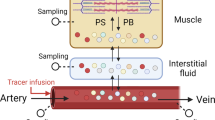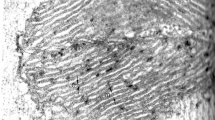Abstract
KLEIBER1,2 first reported in 1932 the concept that a linear relation exists between the logarithms of metabolic rate and, body-weight. The basal rate of oxygen consumption per gram of body-weight was found to be proportional to an exponential function of the body-weight (oxygen consumption × weight−3/4 = constant)3. More recent observations have suggested that this correlation of body-weight and metabolic rate can be extended to the concentration of specific oxidative enzymes. Total body content and contents in various mammalian organs of cytochrome oxidase4, homogentisic oxidaso and p-hydroxy-phenyl-pyruvate oxidase5 have been observed to be related to the body-weight by this same mathematical expression1. Since the logarithm of the total body enzyme activity (E)/g body-weight is linearly related to the logarithm of the body-weight, a weight parity expression has been used for comparing enzyme activities in animals with different weights by Lin et al.5, where c and k are determined from the intercept and slope: (E × Wk = c). Investigators of small laboratory animals weighing up to 4 kg have revealed that certain transaminases (tyrosine-α-ketoglutarate and phenylalanine-pyruvate) are related to different power functions of the body-weight than those observed with the oxidative enzymes.
This is a preview of subscription content, access via your institution
Access options
Subscribe to this journal
Receive 51 print issues and online access
$199.00 per year
only $3.90 per issue
Buy this article
- Purchase on Springer Link
- Instant access to full article PDF
Prices may be subject to local taxes which are calculated during checkout
Similar content being viewed by others
References
Kleiber, M., Hilgardia, 6, 315 (1932).
Kleiber, M., Physiol. Rev., 27, 511 (1947).
Smith, R. E., Ann. N.Y. Acad. Sci., 62, 403 (1956).
Kunkel, H. O., and Campbell, jun., J. E., J. Biol. Chem., 198, 229 (1952).
Lin, E. C. C., Rivlin, R. S., and Knox, W. E., Amer. J. Physiol., 196, 303 (1959).
Cornelius, C. E., Bishop, J., Switzer, J., and Rhode, E. A., Cornell Vet., 49, 116 (1959).
Lin, E. C. C., and Knox, W. E., J. Biol. Chem., 223, 1186 (1958).
Author information
Authors and Affiliations
Rights and permissions
About this article
Cite this article
CORNELIUS, C. Relation of Body-weight to Hepatic Glutamic Pyruvic Transaminase Activity. Nature 200, 580–581 (1963). https://doi.org/10.1038/200580a0
Issue Date:
DOI: https://doi.org/10.1038/200580a0
Comments
By submitting a comment you agree to abide by our Terms and Community Guidelines. If you find something abusive or that does not comply with our terms or guidelines please flag it as inappropriate.



